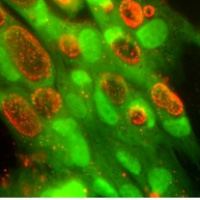Domain Bacteria Rank Phylum | Scientific name Chlamydiae Higher classification Bacteria | |
 | ||
Phylum Chlamydiae; Garrity & Holt 2012 Similar Bacteria, Chlamydophila psittaci, Planctomycetes, Rickettsia, Proteobacteria | ||
The Chlamydiae are bacterial phylum and class whose members are obligate intracellular pathogens. They are ovoid in shape and stain Gram-negative. Historically it was believed that all Chlamydiae species had a peptidoglycan-free cell wall, but recent work demonstrates a detectable presence of peptidoglycan, as well as other important proteins. Many species belonging to this order are susceptible to antimicrobial agents. All known Chlamydiae only grow by infecting eukaryotic host cells. They are as small as or smaller than many viruses. They are dependent on replication inside the host cells, thus are termed obligate intracellular pathogens. Most intracellular Chlamydiae are located in an inclusion body or vacuole. Outside of cells, they survive only as an extracellular infectious form. Chlamydiae can grow only where their host cells grow, and develop according to a characteristic biphasic developmental cycle. Therefore, Chlamydiae cannot be propagated in bacterial culture media in the clinical laboratory. Chlamydiae are most successfully isolated while still inside their host cells.
Contents
History
Chlamydia-like disease affecting the eyes of people was first described in ancient Chinese and Egyptian manuscripts. A modern description of chlamydia-like organisms was provided by Halberstaedrrter and von Prowazek in 1907. Chlamydial isolates cultured in the yolk sacs of embryonating eggs were obtained from a human pneumonitis outbreak in the late 1920s and early 1930s, and by the mid-20th century, isolates had been obtained from dozens of vertebrate species. The term 'chlamydia' (a cloak) appeared in the literature in 1945, although other names continued to be used, including Bedsonia, Miyagawanella, ornithosis-, TRIC-, and PLT-agents.
Nomenclature
In 1966, Chlamydiae were recognized as bacteria and the genus Chlamydia was validated. The order Chlamydiales was created by Storz and Page in 1971. The class Chlamydiia was recently validly published. Between 1989 and 1999, new families, genera, and species were recognized. The phylum Chlamydiae was established in Bergey's Manual of Systematic Bacteriology. By 2006, genetic data for over 350 chlamydial lineages had been reported,
Taxonomy and molecular signatures
The Chlamydiae currently contain eight validly named genera, and 14 candidatus genera. The phylum presently consist of two orders (Chlamydiales, [Parachlamydiales) and nine families within a single class (Chlamydiia). Only four of these families are validly named (Chlamydiaceae, Parachlamydiaceae, Simkaniaceae, Waddliaceae) while five are described as Candidatus families (Clavichlamydiaceae, Criblamydiaceae, Parilichlamydiaceae, Piscichlamydiaceae, and Rhabdochlamydiaceae). The Chlamydiales order as recently described contains the families Chlamydiaceae', and the Candidatus Clanchiamydiaceae, while the new Parachlamydiales' order harbours the remaining seven families. This proposal is supported by the observation of two distinct phylogenetic clades that warrant taxonomic ranks above the family level. Molecular signatures in the form of conserved indels (CSIs) and proteins (CSPs) have been found to be uniquely shared by each separate order, providing a means of distinguishing each clade from the other and supporting the view of shared ancestry of the families within each order. The distinctness of the two orders is also supported by the fact that no CSIs were found among any other combination of families.
Molecular signatures have also been found that are exclusive for the [Chlamydiaceae family. The Chlamydiaceae originally consisted of two genera, Chlamydophila and Chlamydia. The genera have been recently united where species belonging to the Chlamydophila genus have been reclassified as Chlamydia species. However, CSIs and CSPs have been found specifically for Chlamydophila species, supporting their distinctness from Chlamydia, perhaps warranting additional consideration of two separate groupings within the family. CSIs and CSPs have also been found that are exclusively shared by all Chlamydia that are further indicative of a lineage independent from Chlamydophila, supporting a means to distinguish Chlamydia species from neighbouring Chlamydophila members.
Phylogenetics
The Chlamydiae form a unique bacterial evolutionary group that separated from other bacteria about a billion years ago, and can be distinguished by the presence of several CSIs and CSPs. The species from this group can be distinguished from all other bacteria by the presence of conserved indels in a number of proteins and by large numbers of signature proteins that are uniquely present in different Chlamydiae species. Reports have varied as to whether the Chlamydiae are related to the Planctomycetales or Spirochaetes. Genome sequencing, however, indicates that 11% of the genes in Candidatus Protochlamydia amoebophila UWE25 and 4% in the Chlamydiaceae are most similar to chloroplast, plant, and cyanobacterial genes. Cavalier-Smith has postulated that the Chlamydiae fall into the clade Planctobacteria in the larger clade Gracilicutes. However, phylogeny and shared presence of CSIs in proteins that are lineage-specific indicate that the Verrucomicrobia are the closest free-living relatives of these parasitic organisms. Comparison of ribosomal RNA genes has provided a phylogeny of known strains within Chlamydiae.
Human pathogens and diagnostics
Three species of Chlamydiae that commonly infect humans are described:
The unique physiological status of the Chlamydiae including their biphasic lifecycle and obligation to replicate within a eukaryotic host has enabled the use of DNA analysis for chlamydial diagnostics. Horizontal transfer of genes is evident and complicates this area of research. In one extreme example, two genes encoding histone-like H1 proteins of eukaryotic origin have been found in the prokaryotic genome of C. trachomatis, an obligate intracellular pathogen.
Phylogeny
The phylogeny is based on 16S rRNA-based LTP release 123 by The All-Species Living Tree Project.
Notes:
♠ Strains found at the National Center for Biotechnology Information (NCBI) but not listed in the List of Prokaryotic names with Standing in Nomenclature (LSPN)
♥ Strains not lodged at National Center for Biotechnology Information (NCBI) and or listed in the List of Prokaryotic names with Standing in Nomenclature (LPSN)
Taxonomy
The currently accepted taxonomy is based on the List of Prokaryotic names with Standing in Nomenclature (LPSN) and the NCBI
